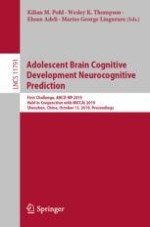2019 | Buch
Adolescent Brain Cognitive Development Neurocognitive Prediction
First Challenge, ABCD-NP 2019, Held in Conjunction with MICCAI 2019, Shenzhen, China, October 13, 2019, Proceedings
herausgegeben von: Kilian M. Pohl, Wesley K. Thompson, Dr. Ehsan Adeli, Marius George Linguraru
Verlag: Springer International Publishing
Buchreihe : Lecture Notes in Computer Science
